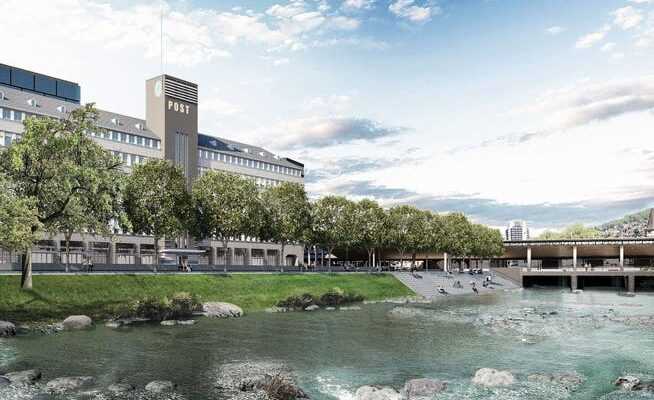The municipal council says yes to a new stone staircase on Europaallee. And the debate about urban pigeons inspires the city parliamentarians.
According to the city council, bird species will rarely be observed on the undesigned banks of the Sihl.
In hardly any other city is access to the waters as easy as in Zurich. Elsewhere, unsavory broths roll through walled-up riverbeds – here you bathe in river and lake. In this respect, the Sihl falls behind a bit: It will probably never be a bathing river because its water level fluctuates and because the water quality is borderline. But access to the Sihl should also be improved. The banks of Europaallee are to be redesigned based on the model of the Sigi-Feigel-Terrace on Gessnerallee.
On the left bank of the Sihl in the area in front of the Sihlpost, a 70-meter-long seating system is planned, which will reach from the upper edge of the embankment down to the Sihl, 13 rows of natural stone steps.
3.8 million for 13 levels
In the city parliament, only the SVP opposed this project on Wednesday, primarily for reasons of cost. 3.8 million francs for 13 steps – that’s too much, says local councilor Derek Richter, especially in view of the city’s forecast deficits in the hundreds of millions in the coming years. It was “a luxury project after all”, despite the city council’s assertions to the contrary. In addition, the stairs will cause “enormous maintenance costs” because littering is to be expected. And to such an extent that a full-time job would be necessary to eliminate it.
The fact that the costs are still as high as in the original planning is not an issue in the municipal council – even though a planned footbridge between Europaallee and Gessnerallee has been cancelled.
Markus Knauss (Greens) points out that the effective costs are lower. The city has to set aside around one million Swiss francs in the event that the staircase has to be dismantled again in 25 years. The city must apply for a water concession from the canton, which is always limited. The risk that the canton will insist on dismantling and restoring the natural embankment seems very theoretical, especially as the canton welcomes the project. Nevertheless, Richter drew the conclusion that the stairs were “unnatural”.
The kingfisher has been sighted
Knauss points out that the city and SBB designed the river Sihl naturally. With the natural stone staircase, people can “experience” this natural space. In fact, according to the city council, one can observe endangered fish species in this place. The rare kingfisher has also been sighted there several times. Construction of the seating steps is scheduled to begin in 2024, and construction will take a year.
The phased project is not the only one to receive city parliament approval on Wednesday. This also approves the project planning loan for a park near the port of Enge. 127 public parking spaces are to disappear into Swiss Re’s underground car park. A park with a wide passage leading to the harbor is planned. Finally, a majority also found an SP postulate, according to which wooden walkways with seating should be created on the Limmat between the Rathausbrücke and the Drahtschmidlisteg.
The big egg stealer
There is more to talk about than the access to the water is a move by the outgoing SP municipal councilor Urs Helfenstein. It’s about the animal, more precisely: about the pigeon welfare. Helfenstein wants the city council to take an animal-friendly approach to the pigeon problem. At first glance, the approach he proposes seems absurd. City employees are supposed to steal the real eggs from the pigeon nests and replace them with clay ones. The animals then give in to the illusion of incubating, but have no offspring.
As strange as it may sound, this plan apparently works in other cities, as emphasized by several speakers in the city parliament. The responsible city councilor Richard Wolff (AL) does not want to accept the request. You have studied the model and do not have enough employees to replace the eggs of the 16,000 pigeons in the city area. The main problem is feeding the pigeons out of a misunderstood love of animals, and only a feeding ban can help against that. Such is provided for in the cantonal hunting law.
The topic inspires the city parliamentarians. Walter Anken (SVP) reveals that as a child he once kept pigeons himself. Simon Kälin (Greens) talks about the intelligence of animals, which are even able to distinguish a painting by van Gogh from one by Klimt.
Andreas Egli (FDP) goes too far with the high spirits that the speakers get into on this topic. The debate has a “pathetically low level”; the city’s experts know what needs to be done, he says. And he refrains from filling his speaking time with personal experiences and half-knowledge about pigeons from the Internet.
But the animal lovers prevail. They accept the postulate by a vote of 82 to 18. The city council needs to give serious consideration to the model with the clay eggs.
